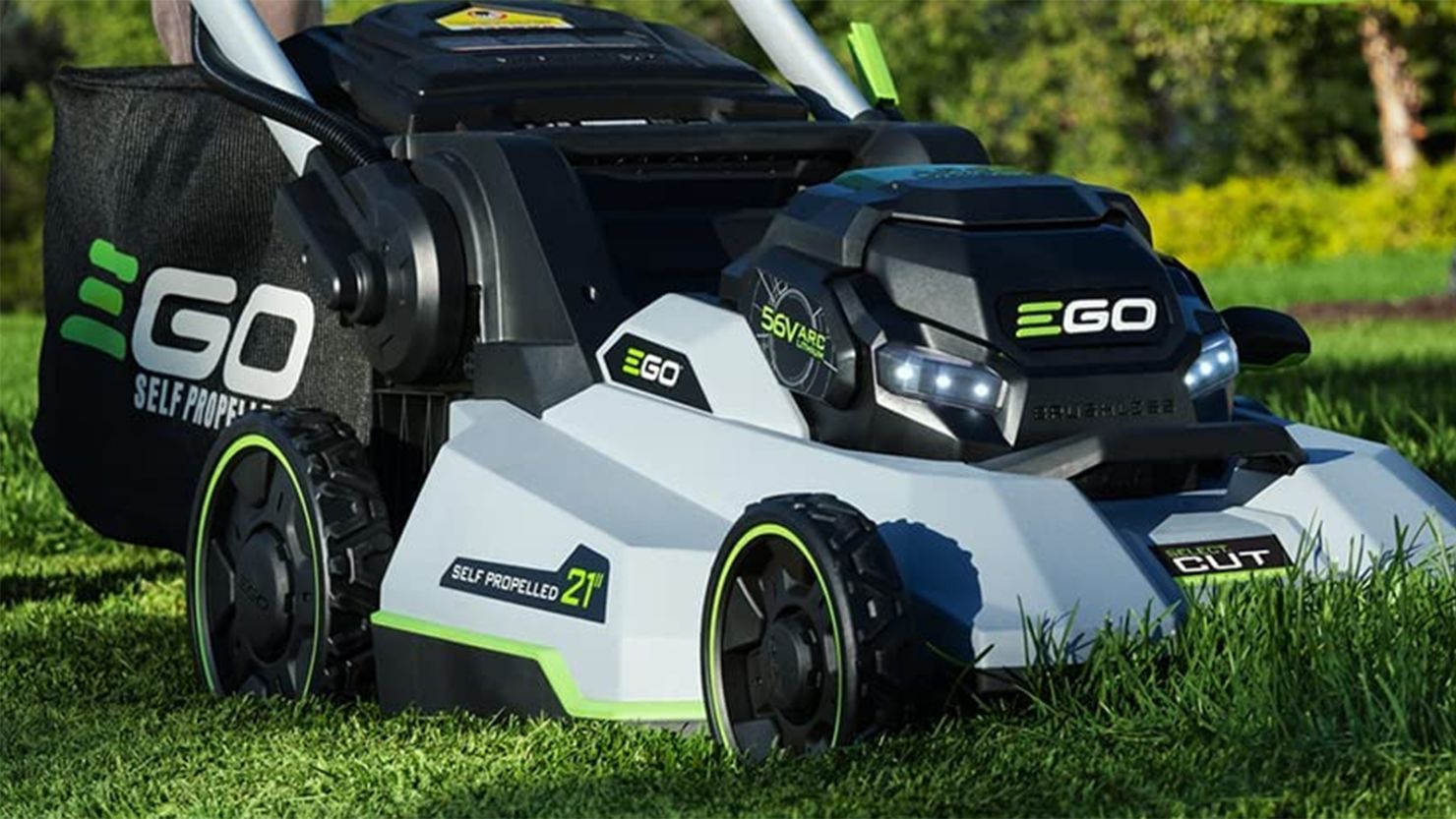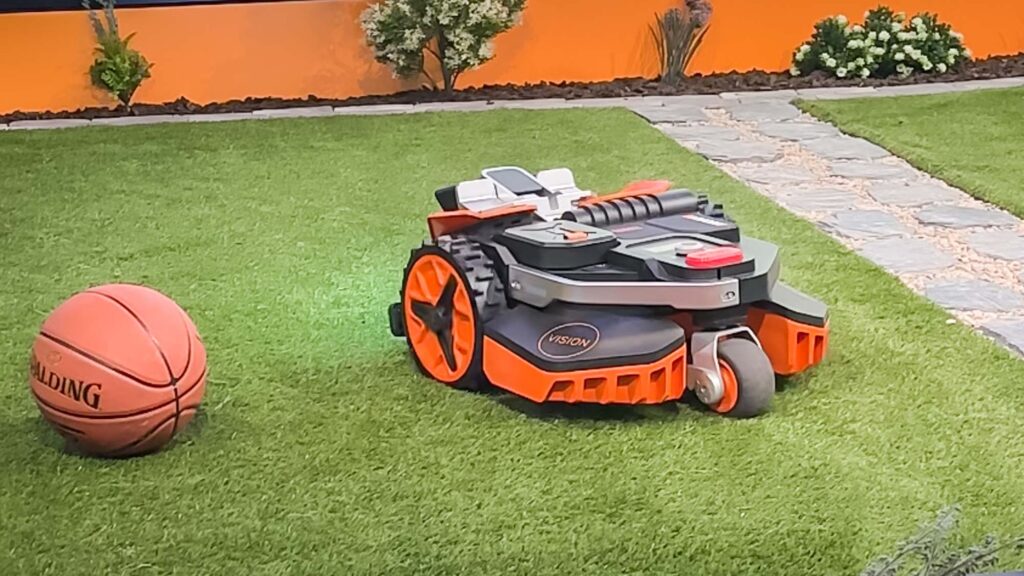Maintaining a lush, well-manicured lawn often begins with selecting the right Types of Lawnmowers. With various types of lawnmowers available on the market, each offering unique features and capabilities, the choice can be daunting. Whether you have a small urban lawn or acres of sprawling grassland, understanding the different types of lawnmowers and their advantages can help you make an informed decision. In this guide, we’ll explore the diverse landscape of lawnmowers, from traditional gas-powered models to cutting-edge robotic mowers, equipping you with the knowledge to achieve lawn perfection.
1. Push Reel Mowers
Push reel mowers, also known as manual reel mowers or cylinder mowers, are lawn mowers that operate without the need for electricity, gasoline, or any other external power source. They have a simple design consisting of a cylindrical reel of blades mounted on a horizontal shaft, which is connected to wheels and a handle. As you push the mower across the lawn, the spinning blades cut the grass.

These mowers are powered by the user’s pushing force, which rotates the reel. They are often preferred for their eco-friendliness, quiet operation, and the clean, scissor-like cut they provide, which promotes healthier grass growth. Push reel mowers are typically lightweight, easy to maneuver, and require minimal maintenance compared to gas-powered or electric mowers. They’re especially suitable for small to medium-sized lawns with relatively even terrain
Pros and Cons
| Pros | Cons |
| 1. Environmentally Friendly: Push reel mowers don’t rely on gasoline or electricity, making them an eco-friendly option. They produce zero emissions, reducing your carbon footprint. 2. Quiet Operation: Since push reel mowers don’t have engines, they operate quietly, making them ideal for early morning or late evening mowing without disturbing neighbors. 3. Low Maintenance: They have fewer moving parts compared to gas or electric mowers, which means less maintenance is required. You don’t need to worry about oil changes, spark plugs, or engine tune-ups. 4. Cost-effective: Push reel mowers are typically more affordable to purchase upfront compared to gas or electric mowers. Additionally, there are no ongoing fuel or electricity costs. | 1. Requires Effort: Push reel mowers rely solely on human power to operate, so they require more physical effort to push, especially through thick or tall grass. This can be challenging for some individuals, particularly on larger lawns. 2. Limited Cutting Height: Push reel mowers may struggle with cutting very tall or thick grass effectively. They work best when grass is kept relatively short and mowing is done more frequently. 3. Not Suitable for All Lawns: If your lawn has lots of obstacles like rocks, sticks, or uneven terrain, push reel mowers may not be the best choice as they can get stuck or damaged more easily than gas or electric mowers. 4. Time-consuming: Since push reel mowers require more effort and may not be as effective at cutting tall or thick grass, mowing with them can take longer compared to using a gas or electric mower. |
2. Gas-powered lawnmowers
Gas-powered lawnmowers are machines used for cutting grass in residential, commercial, or industrial settings. Unlike electric or manual lawnmowers, which rely on electricity or human power, gas-powered lawnmowers are equipped with internal combustion engines fueled by gasoline. These engines power the blades that cut the grass as the mower is pushed or propelled across the lawn. Gas-powered lawnmowers are known for their effectiveness in cutting through thick grass and covering larger areas compared to electric or manual alternatives. However, they require regular maintenance, including oil changes, fuel refills, and occasional tune-ups. They also produce emissions during operation, contributing to air pollution, and can be noisier compared to electric models.

Pros and Cons
| Pros | Cons |
| 1. Power: Gas-powered lawnmowers typically have more power than their electric counterparts, making them suitable for cutting through thick or tall grass. 2. Portability: Gas mowers are not limited by the length of a power cord, providing greater freedom of movement around the yard. 3. Fast Refueling: Refueling a gas mower is quick and easy, allowing you to get back to mowing without waiting for batteries to recharge. | 1. Noise and Pollution: Gas-powered lawnmowers are typically louder than electric models and emit pollutants such as carbon monoxide and hydrocarbons. 2. Maintenance: Gas mowers require regular maintenance, including oil changes, spark plug replacements, and air filter cleanings, which can add to their overall cost of ownership. 3. Emissions: Gas-powered mowers contribute to air pollution and greenhouse gas emissions, which can have negative environmental impacts. |
3. Electric Lawnmowers
Electric lawnmowers are lawn care machines powered by electricity rather than gasoline. They typically come in two main types: corded and cordless.
- Corded Electric Lawnmowers: These mowers are powered by electricity via a cord that must be plugged into an electrical outlet. They are generally lighter and more affordable than their cordless counterparts but have the limitation of needing to be used within range of an electrical outlet.
- Cordless Electric Lawnmowers: Cordless electric lawnmowers run on rechargeable batteries, providing more freedom of movement since they don’t require a cord. They are convenient for larger yards or areas where access to electrical outlets might be limited. However, they may be heavier due to the battery, and users need to monitor battery life to ensure uninterrupted mowing.

Pros and Cons
| Pros | Cons |
| 1. Environmentally Friendly: Electric lawnmowers produce zero emissions during operation, making them more environmentally friendly than gas-powered mowers. They help reduce air and noise pollution, contributing to a cleaner and quieter environment. 2. Low Maintenance: Electric mowers have fewer moving parts compared to gas mowers, which means they generally require less maintenance. There’s no need for oil changes, spark plug replacements, or carburetor adjustments. 3. Convenience: Cordless electric mowers provide the convenience of unrestricted movement since they don’t require a power cord. This makes them suitable for larger lawns where maneuverability may be a concern. 4. Ease of Use: Electric mowers are typically lighter and easier to maneuver than gas mowers, making them ideal for homeowners who may struggle with heavier equipment. 5. Quieter Operation: Electric mowers are significantly quieter than gas mowers, which can be a significant benefit for homeowners in residential areas or those who prefer a quieter mowing experience. 6. Cost Savings: While electric mowers may have a higher upfront cost compared to some gas models, they tend to be more cost-effective to operate in the long run due to lower fuel and maintenance costs. | 1. Limited Runtime (Cordless Models): Cordless electric mowers are limited by their battery life, which may not be sufficient for larger lawns. Depending on the battery capacity, you may need to recharge multiple times for extensive mowing sessions. 2. Power Output: Electric mowers, especially cordless models, may have less power compared to gas mowers. This can result in reduced cutting performance, particularly in thick or tall grass. 3. Dependency on Power Source: Corded electric mowers require access to a power outlet and are limited by the length of the cord. This can be inconvenient for larger yards or areas without easy access to electricity. 4. Battery Replacement Costs: For cordless electric mowers, the batteries may need to be replaced periodically, which can be an additional expense. However, advancements in battery technology are improving battery lifespan and reducing replacement costs over time. 5. Initial Cost: While electric mowers can save money in the long run, they often have a higher upfront cost compared to some gas-powered models. This initial investment may deter some buyers, especially if they have a smaller budget. 6. Not Suitable for Heavy-Duty Use: Electric mowers may struggle with heavy-duty tasks such as cutting dense or overgrown grass. Gas-powered mowers are generally better suited for these situations due to their higher power output. |
4. Robotic Lawnmowers
Robotic lawnmowers are autonomous machines designed to mow lawns without human intervention. They typically operate within a predefined area, navigating using sensors, GPS, or boundary wires. These devices are equipped with blades to cut grass to a specified height. Many models can be programmed to operate at specific times or even controlled remotely via smartphone apps. They offer convenience and save time for homeowners by automating the lawn care process.

Pros and Cons
| Pros | Cons |
| 1. Convenience: Perhaps the most significant advantage is their convenience. Once set up, robotic lawnmowers can operate autonomously, saving you time and effort. 2. Time-saving: Since they work autonomously, you can multitask or relax while they mow your lawn. This can be particularly useful for busy individuals or those with limited mobility. 3. Consistent Cutting: Robotic lawnmowers typically operate on a schedule, ensuring your lawn is consistently trimmed. This can result in a more even and professional-looking lawn compared to irregular human mowing. 4. Quiet Operation: They are generally quieter than traditional lawnmowers, making them more suitable for early morning or late evening mowing without disturbing neighbors. | 1. Initial Cost: Robotic lawnmowers tend to have a higher initial cost compared to traditional lawnmowers. However, this cost may be offset by the time and effort saved over the long term. 2. Limited Coverage: While robotic lawnmowers are suitable for many lawn sizes, they may struggle with very large or irregularly shaped lawns. Additionally, obstacles such as trees, flower beds, or steep slopes can pose challenges. 3. Setup Complexity: Setting up a robotic lawnmower involves installing boundary wires to define the mowing area and may require some technical know-how. Initial setup can be time-consuming and may require adjustments to optimize performance. 4. Maintenance: While robotic lawnmowers require less day-to-day maintenance compared to traditional mowers, they still need periodic cleaning, blade sharpening, and battery maintenance. Additionally, troubleshooting technical issues may require some expertise. |
5. Riding lawnmowers
Riding lawnmowers are a convenient and efficient way to maintain larger lawns. They’re essentially small vehicles equipped with a cutting deck underneath for mowing grass. They come in various sizes, from smaller models suitable for residential lawns to larger, more powerful machines used for commercial purposes or extensive estates.

Pros and Cons
| Pros | Cons |
| 1. Efficiency: Riding lawnmowers are typically faster than push mowers, allowing you to cover more ground in less time. 2. Less physical strain: Since you’re sitting while mowing, riding lawnmowers are less physically demanding compared to push mowers, making them ideal for those with mobility issues or large lawns. 3. Versatility: Many riding lawnmowers come with attachments such as baggers, mulchers, and trailers, allowing you to perform various lawn care tasks with a single machine. 4. Comfort: Riding lawnmowers often come with comfortable seats, adjustable controls, and other ergonomic features, making them more comfortable to operate for extended periods. | 1. Cost: Riding lawnmowers are typically more expensive than push mowers, both in terms of upfront purchase price and ongoing maintenance costs. 2. Storage space: They require more storage space compared to push mowers, which can be an issue for those with limited garage or shed space. 3. Terrain limitations: Riding lawnmowers may struggle with steep slopes or uneven terrain, limiting their effectiveness in certain areas of your yard. 4. Fuel consumption: Riding lawnmowers tend to consume more fuel than push mowers, which can add up over time, especially for larger lawns. |
6. Hover mowers
Hover mowers are a unique type of lawnmower that utilize a cushion of air to glide smoothly over the lawn, rather than rolling on wheels like traditional mowers. Hover mowers can be a great option for those with smaller or irregularly shaped lawns, or for anyone looking for a lightweight and maneuverable mower option. However, it’s important to consider your specific lawn care needs and preferences before making a decision.

Pros and Cons
| Pros | Cons |
| 1. Maneuverability: Hover mowers are highly maneuverable, able to easily navigate around obstacles and tight spaces in the lawn. 2. Lightweight: They are typically lighter than traditional mowers, making them easier to push and maneuver, especially on slopes or uneven terrain. 3. Versatility: Hover mowers can often be used on a variety of lawn types, including uneven or sloped surfaces, where traditional mowers may struggle. 4. Cutting edge access: Their design allows them to cut right up to the edge of flowerbeds, pathways, and other obstacles with ease. | 1. Limited cutting height: Hover mowers often have limited cutting height adjustment compared to traditional mowers, which may not be suitable for all types of grass or desired lawn heights. 2. Grass collection: Many hover mowers do not come with grass collection boxes, meaning grass clippings are left on the lawn, which may not be suitable for all users. 3. Noise and vibration: Some users find that hover mowers can be noisier and produce more vibration compared to traditional mowers, which may be a consideration for those with noise sensitivities or nearby neighbors. 4. Less common: Depending on your location, hover mowers may be less common and therefore harder to find or service compared to traditional mowers. |

